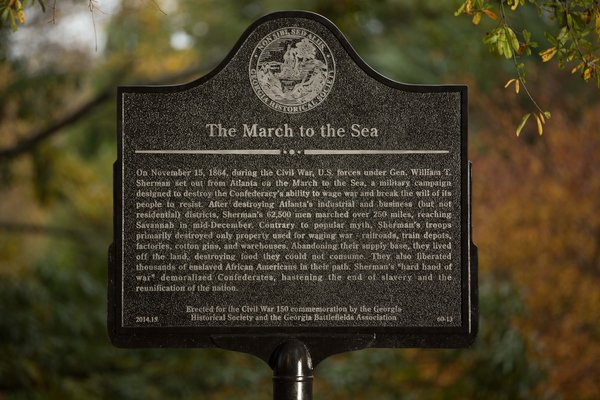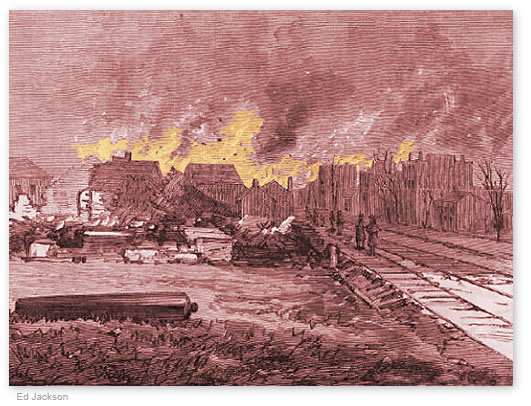“War is the remedy that our enemies have chosen, and I say let us give them all they want.” – Maj. General William T. Sherman
That scowling, growling face is back in the news again, thanks to a highly unlikely source: a simple historical marker.
Many drivers rush by historical plaques without noticing them. Sure, dads would pull over and check them out during family vacations when you were a child, saying “It’s educational,” stranding bored kids in the broiling sun while he read each and every word.
 But a brand new marker erected just last week in Atlanta is getting lots of attention, because it’s reopening old wounds. Nearly 125 years after his death, General Sherman is smack dab in the middle of controversy. Again.
But a brand new marker erected just last week in Atlanta is getting lots of attention, because it’s reopening old wounds. Nearly 125 years after his death, General Sherman is smack dab in the middle of controversy. Again.
Last week marked the 150th anniversary of the start of Sherman’s famous March to the Sea. So the folks at the Georgia Historical Society and the Georgia Battlefields Association figured it was a good time to unveil a new marker on the grounds of the Jimmy Carter Presidential Library and Museum. And that has Northerners and Southerners pointing fingers at each other. Again.
 The New York Times plunged into the controversy a few days ago with a lengthy article by Alan Blinder about the marker. “…Some say its text is an inaccurate portrayal of history that amounts to an academic pardon for a general some believe committed acts that would now be deemed war crimes.”
The New York Times plunged into the controversy a few days ago with a lengthy article by Alan Blinder about the marker. “…Some say its text is an inaccurate portrayal of history that amounts to an academic pardon for a general some believe committed acts that would now be deemed war crimes.”
That text begins benignly enough. “On November 15, 1864, during the Civil War, U.S. forces under William T. Sherman set out from Atlanta on the March to the Sea, a military campaign designed to destroy the Confederacy’s ability to wage war and break the will of its people to resist.” Most historians agree on that. But then the text veers into historical revisionism with this explosive line: “Contrary to popular myth, Sherman’s army primarily destroyed only property used for waging war – railroads, train depots, factories, cotton gins, and warehouses.”
Let’s pause a minute and examine what happened during that military operation.
By the fall of 1864, the South was on its last legs. Sherman sent 62,500 men heading for Savannah against the lightest of token opposition, sweeping it aside with minimal effort. That’s when the matches came out and the torches were lit.
 The wildly popular song (among Northerners anyway) Marching Through Georgia chirpily says, “So we made a thoroughfare for freedom and her train; Sixty miles in latitude, three hundred to the main.” Put another way, they left a trail of smoldering ashes 60 miles wide and 300 miles long, burning much of whatever happened to cross their path.
The wildly popular song (among Northerners anyway) Marching Through Georgia chirpily says, “So we made a thoroughfare for freedom and her train; Sixty miles in latitude, three hundred to the main.” Put another way, they left a trail of smoldering ashes 60 miles wide and 300 miles long, burning much of whatever happened to cross their path.
The new marker says, “…Sherman’s army primarily destroyed only property used for waging war…” Let’s stack that against the words of someone who was there.
I have in my personal collection a letter by Jonathan Messenger, a young Massachusetts soldier, written from Savannah on January 21, 1865. Listen to what he told his family about his experience on the March just a few weeks earlier (spelling, grammar and punctuation are all original):
 “We left Atlanta on the 16th of Nov. had a very pleasant march, it being such nice weather … We distroid every thing, burnt the houses, Barns, Cotton and corn and killed all the hogs, chickens and turkeys to eat and drove off all the cattle mules and horses so there is not much left. Now we want to go through South Carolina and do a little worse there.”
“We left Atlanta on the 16th of Nov. had a very pleasant march, it being such nice weather … We distroid every thing, burnt the houses, Barns, Cotton and corn and killed all the hogs, chickens and turkeys to eat and drove off all the cattle mules and horses so there is not much left. Now we want to go through South Carolina and do a little worse there.”
Hold on a minute. Did you catch the phrase “burnt the houses”? What role did destroying private dwellings and turning hundreds upon hundreds of families out into the cold as winter was approaching play in destroying “only property used for waging war”? And what about the phrase, “there’s not much left”? That strongly indicates wholesale devastation.
But it’s the marker’s “contrary to popular myth” line that is especially galling. One dictionary describes myth as “an invented story, idea, or concept.” Under this rationale, Southerners at least exaggerated the destruction of private property, and at worst completely fabricated it, just to make Sherman (and through him the North itself) look bad. Casually dismissing widespread wanton destruction of private property with the line “contrary to popular myth” is like blaming the victim of a crime to divert attention from the criminal. And it borders on the same rationale used by people who deny the Holocaust happened.
 “Georgians and other Southerners made up those tales of destruction,” this new thinking goes. “The burning during Sherman’s March to the Sea was limited to strictly military objectives.”
“Georgians and other Southerners made up those tales of destruction,” this new thinking goes. “The burning during Sherman’s March to the Sea was limited to strictly military objectives.”
So how do you square that with the very words of the Union soldier who was there? “We burnt the houses…” And the chilling foreshadowing of what was about to happen next: “Now we want to go through South Carolina and do a little worse there.” (Which they proceeded to do, starting just six days after Messenger’s letter was written.)
“Contrary to popular myth…” I wonder what the thousands of women and children left  homeless by Sherman’s soldiers would have thought of that?
homeless by Sherman’s soldiers would have thought of that?
Too bad they didn’t get the chance to talk to the Georgia Historical Society and the Georgia Battlefields Association before those words were cast in metal.
Did you find this enjoyable or helpful? Please continue to join me each week, and I invite you to read Tell it Like Tupper and share your review!
Curious about about Tell It Like Tupper? Here’s a chance to see for yourself. Take a sneak peek at a couple chapters in this free downloadable excerpt.

